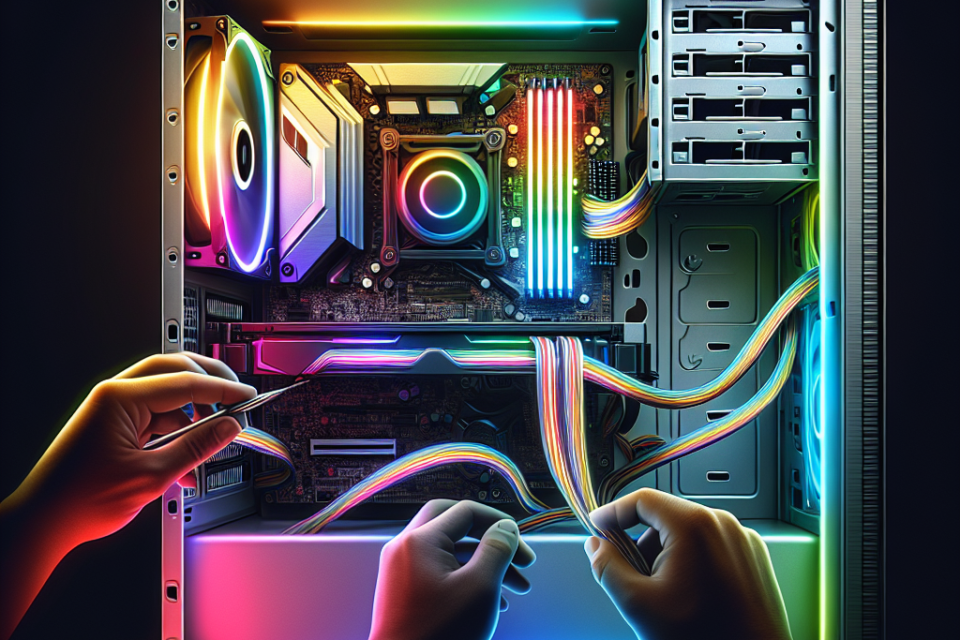How do I set up RGB lighting in my custom PC?

Introduction
Setting up RGB lighting in your custom PC can transform your setup from mundane to extraordinary. Not only does it offer aesthetic appeal, but it also allows for personalization and enhances your overall gaming or work experience. This guide will take you through the necessary steps to install and configure RGB lighting in your custom PC.
Tools and Materials Required
| Item | Description |
|---|---|
| RGB LED Strips/Fans | Multicolored LED strips or fans for lighting |
| RGB Controller | A controller to manage and configure the lighting |
| Power Supply | Ensure your PSU is RGB-compatible |
| Cables and Connectors | Necessary wiring to connect the RGB components |
| Software | RGB control software (e.g., ASUS Aura, MSI Mystic Light) |
| Tools | Screwdrivers, cable ties, double-sided tape, etc. |
Before diving in, ensure you have all the required tools and materials. Most of these items are available at any reputable electronics store or online retailer.
Step-by-Step Installation Guide
1. Planning Your Setup
First, decide which components you want to illuminate. Common choices include:
- Case interior
- CPU cooler
- Motherboard
- RAM modules
- Peripherals (keyboard, mouse)
Plan the placement of your RGB strips or fans to ensure optimal lighting coverage.
2. Installing RGB Strips and Fans
Mounting the Strips
Once you plan the placement, use double-sided tape or clips to mount the RGB strips inside your case. Ensure they are secure but accessible for wiring.
Attaching RGB Fans
Install RGB fans just like standard fans, attaching them to the necessary mounts and securing them with screws. Connect each fan’s RGB cable to the RGB controller or motherboard header.
3. Wiring and Connections
Proper wiring is crucial for both aesthetics and functionality. Follow the manufacturer’s instructions for connecting RGB strips and fans to the RGB controller or the motherboard’s RGB headers.
- Connect RGB components to the controller or motherboard using specified cables.
- Ensure all cables are neatly organized to avoid clutter and possible interference.
Use cable ties to bundle and hide excess wires for a clean, professional look.
4. Powering the RGB Setup
Check that your power supply unit (PSU) is compatible with RGB lighting. Connect the RGB controller’s power cable to the PSU. Ensure all connections are secure to prevent power issues or short circuits.
5. Installing RGB Control Software
Each brand typically provides its own RGB control software. Some popular ones include:
- ASUS Aura Sync
- MSI Mystic Light
- Gigabyte RGB Fusion
- Corsair iCUE
Download and install the appropriate software for your RGB components. Follow the on-screen instructions to configure the lighting effects and synchronizations.
Software Configuration
Once the hardware is installed, it’s time to configure the RGB lighting using the control software. Here’s a general guide:
1. Open the RGB Software
Launch the software associated with your RGB components.
2. Detect RGB Components
Ensure the software detects all connected RGB components. If not, re-check the connections and ensure the components are compatible with the software.
3. Customize Lighting Effects
- Select a pre-set lighting effect or create a custom profile.
- Adjust parameters such as brightness, speed, and color.
- Synchronize lighting effects across multiple components for a cohesive look.
Troubleshooting Tips
1. RGB Hardware Not Detected
- Ensure all connections are properly secured.
- Restart your computer and re-launch the RGB software.
- Update the software and firmware to the latest version.
2. Inconsistent Lighting
- Check for loose cables or damaged connectors.
- Reinstall the RGB software and reset the lighting profiles.
3. Software Crashes
- Ensure your operating system and RGB software are up-to-date.
- Check for conflicting software or drivers.
- Consider reinstalling the RGB software from a fresh download.
Conclusion
Setting up RGB lighting in a custom PC is an exciting project that adds a touch of flair and personalization. By following this guide, you’ll be able to install, configure, and troubleshoot your RGB setup effortlessly. Happy customizing!
